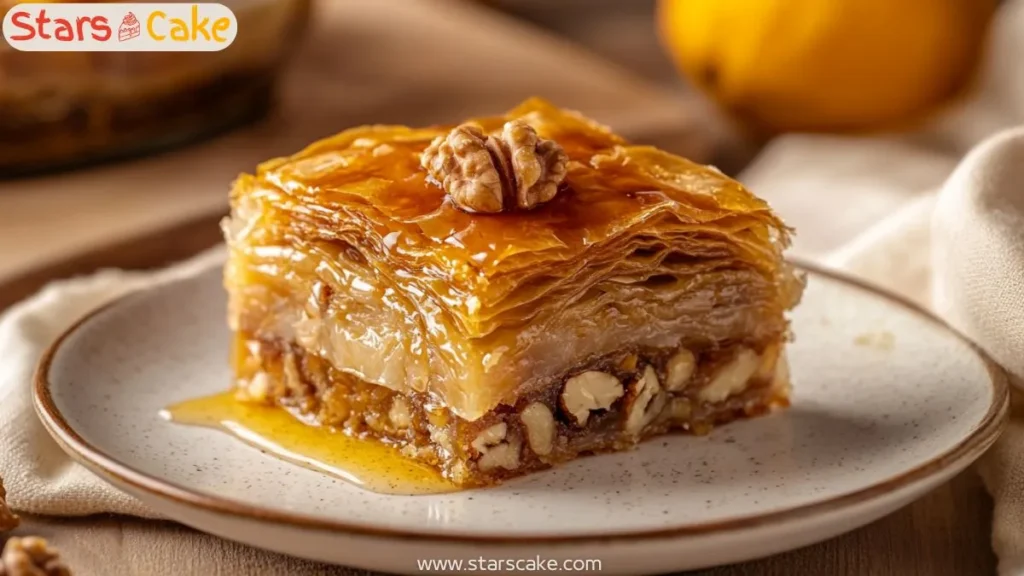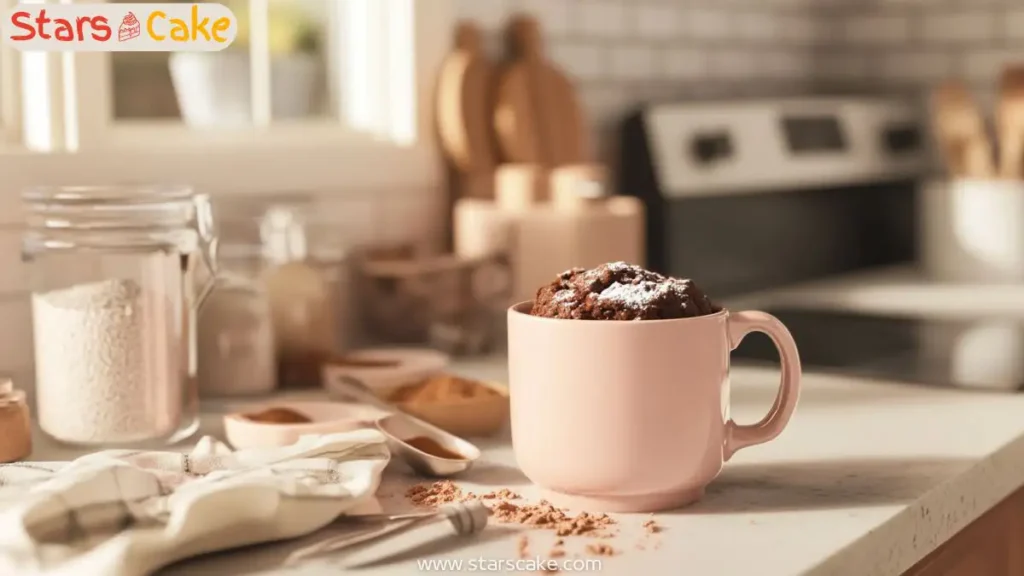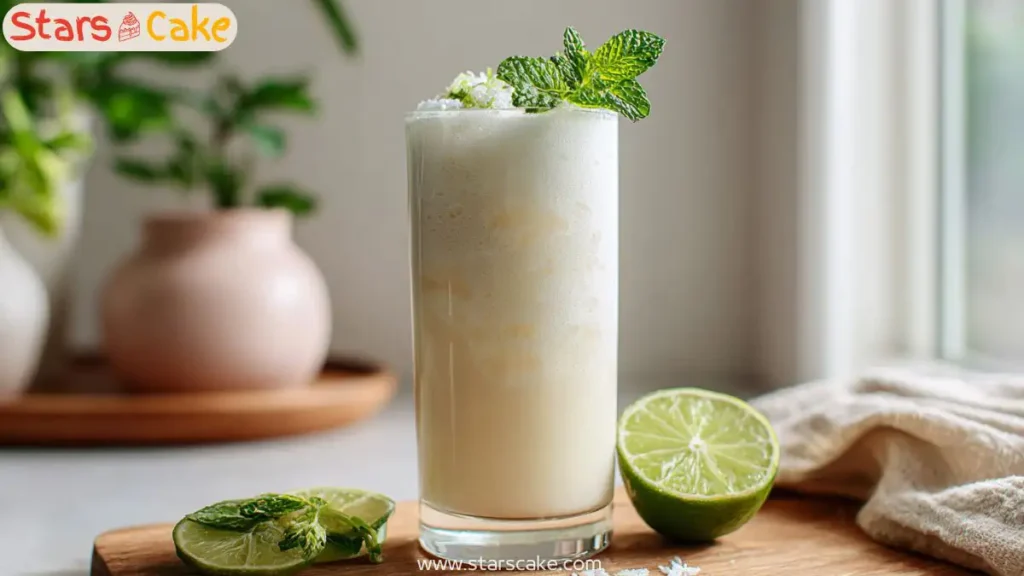Last updated on June 6th, 2025 at 06:48 pm
Table of Contents
There’s something utterly enchanting about baklava—the flaky pastry, the crushed nuts, the sticky honey syrup—it’s a dessert that practically sparkles with tradition. But when you turn it into a cake? Oh, honey, that’s when magic happens. This article guides you through making a baklava cake that brings the iconic flavors of the Mediterranean to your family table in a format that’s perfect for birthdays, holidays, or any day that needs something special. With walnuts, cinnamon spice, and a golden drizzle of honey syrup, this cake is pure joy wrapped in a nutty crunch. Let’s dive into the story behind this recipe and why you’re going to love every layered bite.
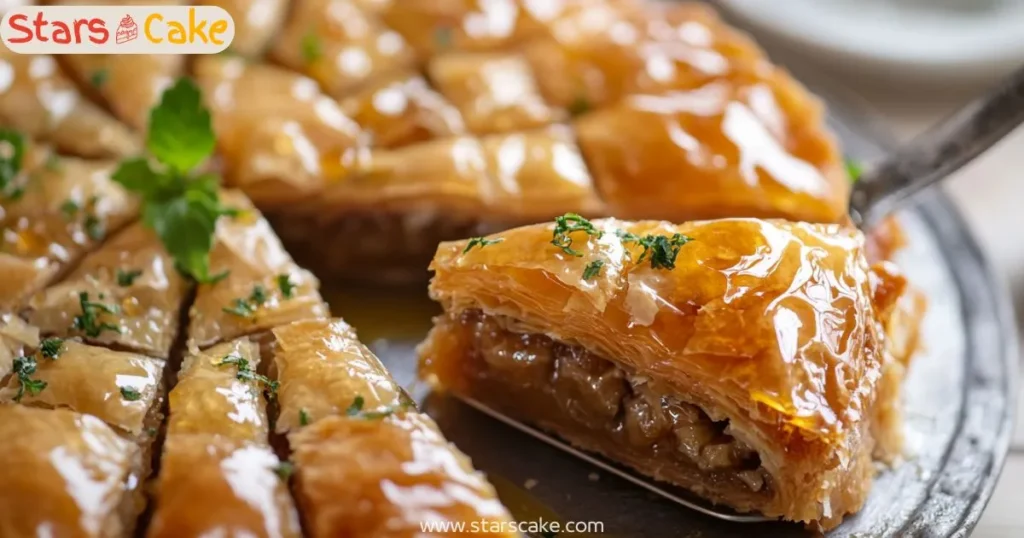
The Story Behind This Easy Baklava Cake
A Family Memory in Every Bite
Growing up, I always loved the smell of my aunt’s kitchen during the holidays. She made baklava the traditional way—phyllo dough brushed with butter, stacked high with chopped walnuts and cinnamon, then soaked in warm honey. It was messy, golden, and unforgettable. But after I had kids, I realized I needed a way to recreate that flavor without spending hours layering pastry sheets. That’s how my baklava cake was born.
Instead of pastry, we use tender spiced cake layers infused with orange zest and cinnamon. The walnut filling stays true to the original—nutty and crunchy—and we pour honey syrup over the top just like the real thing. This cake has that gorgeous Mediterranean flavor, but it’s way easier to slice, serve, and share with the family.
You’ll love the balance of soft cake and sticky-sweet glaze. It’s rich, but not overwhelming—kind of like this Greek Yogurt Cake that’s always a hit. And just like my orange blossom cookies, it’s inspired by traditional ingredients with a modern twist.
What Makes This Baklava Cake So Special
The heart of this cake is the walnut filling. Chopped fine with a touch of cinnamon, sugar, and clove, it mimics that toasty, comforting crunch baklava is known for. And then comes the syrup—boiled gently with honey, orange zest, and a splash of lemon juice. It seeps into the warm cake, adding shine and flavor to every forkful.
What’s even more magical? This cake actually gets better as it sits. The syrup keeps it moist for days, making it a perfect make-ahead dessert for parties or potlucks. No need to fuss with last-minute prep when your cake can already be sitting pretty and soaked in flavor.
Keep reading for a full step-by-step walkthrough—from walnut filling to final drizzle. In the next section, we’ll break down how to make the perfect layers and syrup. Whether you’re new to baking or a seasoned home baker, this recipe will surprise you with how simple it truly is.
Baklava Cake with Honey and Walnuts
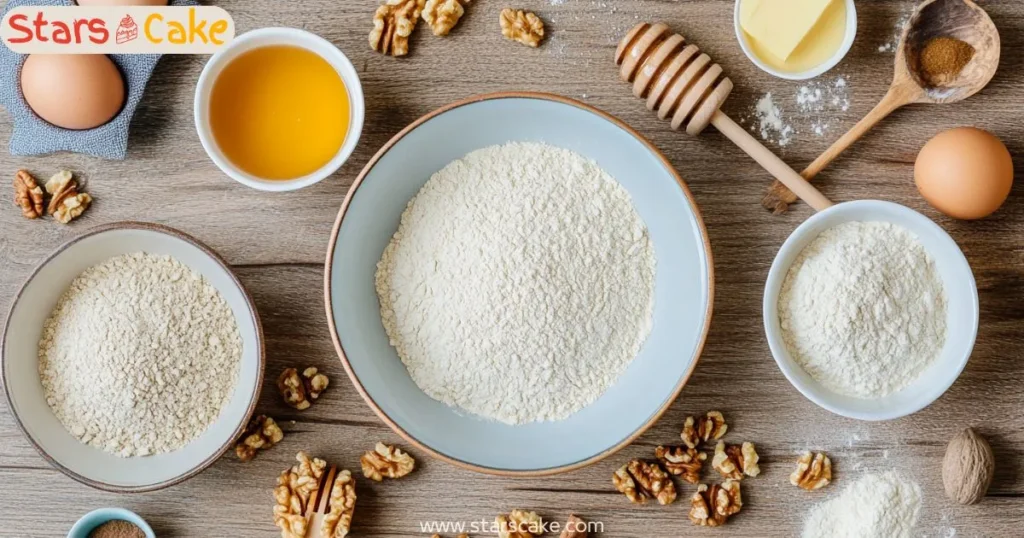
Ingredients
For the Cake Layers
- 2 ½ cups all-purpose flour
- 1 tablespoon baking powder
- ½ teaspoon baking soda
- 1 ½ teaspoons ground cinnamon
- ½ teaspoon ground nutmeg
- ½ teaspoon salt
- 1 cup unsalted butter, softened
- 1 ½ cups granulated sugar
- 3 large eggs
- 1 teaspoon vanilla extract
- 1 tablespoon orange zest
- 1 cup plain yogurt or sour cream
For the Walnut Filling
- 1 ½ cups finely chopped walnuts
- ½ cup brown sugar
- 1 teaspoon ground cinnamon
- Pinch of ground cloves
- Pinch of salt
For the Honey Syrup
- ½ cup honey
- ½ cup granulated sugar
- ½ cup water
- 1 tablespoon lemon juice
- 1 teaspoon orange zest
Directions
- Preheat & Prepare Pans: Preheat oven to 350°F (175°C). Grease two 9-inch cake pans and line with parchment paper.
- Mix Dry Ingredients: In a bowl, whisk together flour, baking powder, baking soda, cinnamon, nutmeg, and salt.
- Cream Butter & Sugar: In a large bowl, beat butter and sugar until light and fluffy (about 3–4 minutes). Add eggs one at a time, then mix in vanilla and orange zest.
- Add Dry and Wet: Add flour mixture in three parts, alternating with yogurt. Start and end with the flour mixture. Do not overmix.
- Make Walnut Filling: Combine walnuts, brown sugar, cinnamon, clove, and salt in a bowl.
- Layer the Cake: Spread half the batter into each cake pan. Sprinkle walnut filling evenly on top. If desired, gently swirl in with a knife.
- Bake: Bake for 35–40 minutes or until a toothpick comes out clean. Cool in the pan for 10 minutes, then transfer to a rack.
- Make Honey Syrup: While the cake bakes, combine syrup ingredients in a saucepan. Simmer on low for 8–10 minutes until slightly thickened.
- Assemble & Soak: While cakes are still warm, spoon syrup slowly over each. Let it soak in before stacking or serving.
- Optional Garnish: Sprinkle crushed walnuts or drizzle extra honey on top before serving.
Crafting the Layers of Baklava Cake
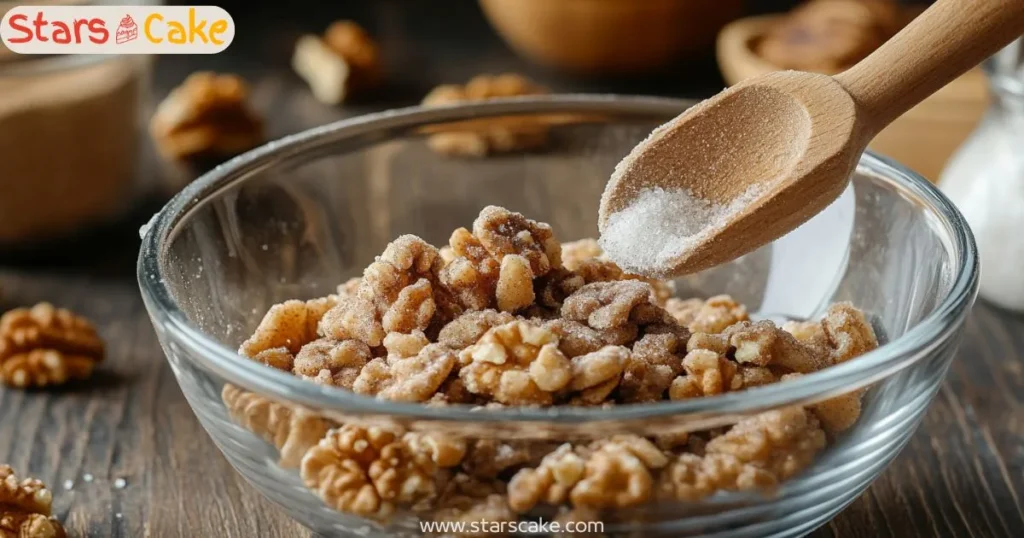
Walnut Filling with a Crunch
Every bite of baklava cake needs that signature crunch, and walnuts are the star of the show. Start by toasting your chopped walnuts for just a few minutes until they’re fragrant. This deepens their flavor and brings out the natural oils—trust me, it makes a huge difference. You’ll mix them with sugar, cinnamon, a tiny pinch of ground clove, and a sprinkle of salt to enhance the sweetness.
This mixture gets layered between soft, spiced cake batter, just like the filling in a traditional baklava. Instead of dozens of thin phyllo sheets, we build this cake in two or three thick, fluffy layers. You’ll spoon the nut mixture evenly over the batter, letting it bake right in so you still get the surprise crunch without the fuss.
It’s very similar in spirit to my easy nut swirl coffee cake, where the filling does the heavy lifting in terms of flavor and texture. The goal is to give you the feeling of baklava—but softer, sliceable, and totally cozy.
Sweet Honey Syrup and Spiced Cake Layers
The real magic comes after baking. While your cake cools slightly, you’ll prepare a syrup that’s as traditional as it gets: honey, sugar, water, lemon juice, and orange zest simmered together. The result is a golden, glossy drizzle that adds moisture and sweetness—just like the syrup you pour over classic baklava. You’ll want to slowly spoon it over the cake while it’s still warm so it soaks into every nook and cranny.
The cake itself is spiced just right—not too overpowering. Cinnamon is the key note, with hints of nutmeg and citrus to round it out. Think of it like a cross between a spice cake and a semolina cake in texture—hearty but tender.
If you’ve ever tried my honey pistachio loaf, you’ll know how well honey complements Mediterranean-inspired desserts. This baklava cake takes that same idea and transforms it into a showstopping centerpiece.
Assembling & Baking the Cake
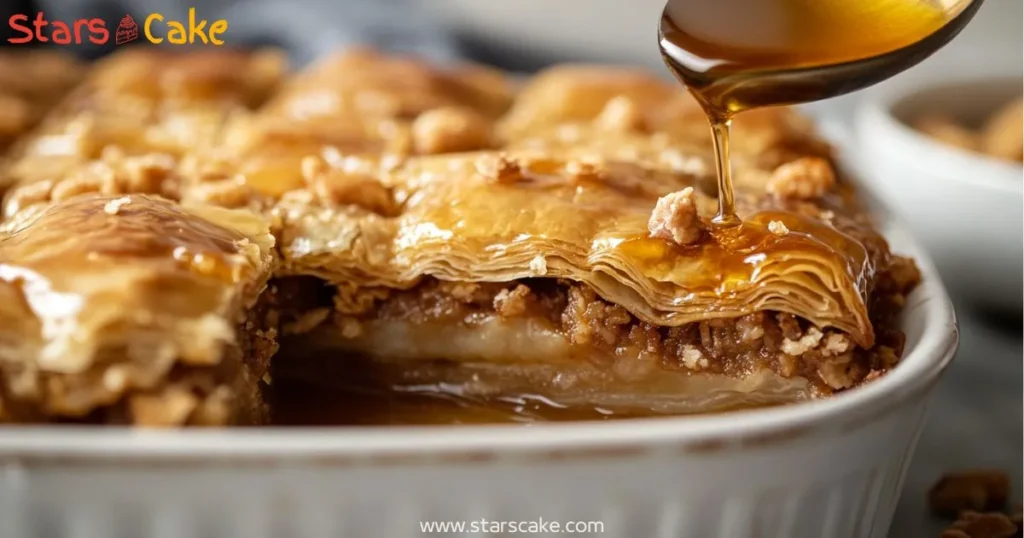
Layering Like a Pro
Once you’ve prepared your batter and walnut filling, it’s time to build your baklava cake. Grease and line your cake pans, then pour in half of your spiced batter. Smooth it out gently, then sprinkle the entire surface with a generous layer of the walnut-sugar mixture. Make sure it reaches the edges so you get that delicious crunch in every bite.
Top with the remaining batter, and if you’re going for a triple-layer cake, repeat the process with thinner layers. Don’t worry if things look rustic—that’s part of the charm. You’re not aiming for perfection; you’re aiming for flavor and love.
This layering process reminds me a bit of my cinnamon roll bundt cake, where the goal is flavor packed into every swirl. If some filling peeks through during baking? Even better—it toasts beautifully on top.
Getting That Signature Golden Finish
Preheat your oven to 350°F (175°C) and bake until the cake springs back lightly and a toothpick comes out with a few moist crumbs—about 35–40 minutes depending on the size of your pans. While it bakes, your kitchen will fill with the warm scent of honey and spice. It’s cozy, nostalgic, and deeply inviting.
Once out of the oven, let the cake cool for 10–15 minutes. Now comes the best part: spooning the warm honey-orange syrup over the top. Go slowly, letting the syrup soak into the cake gradually. This not only adds moisture but gives the finished cake its glossy, golden crown.
Want to make it even more stunning? Sprinkle crushed walnuts on top while the syrup is still sticky, just like I do with my no-fuss walnut apple cake. It adds sparkle and a little extra crunch with minimal effort.
Serving, Storing, and Celebrating
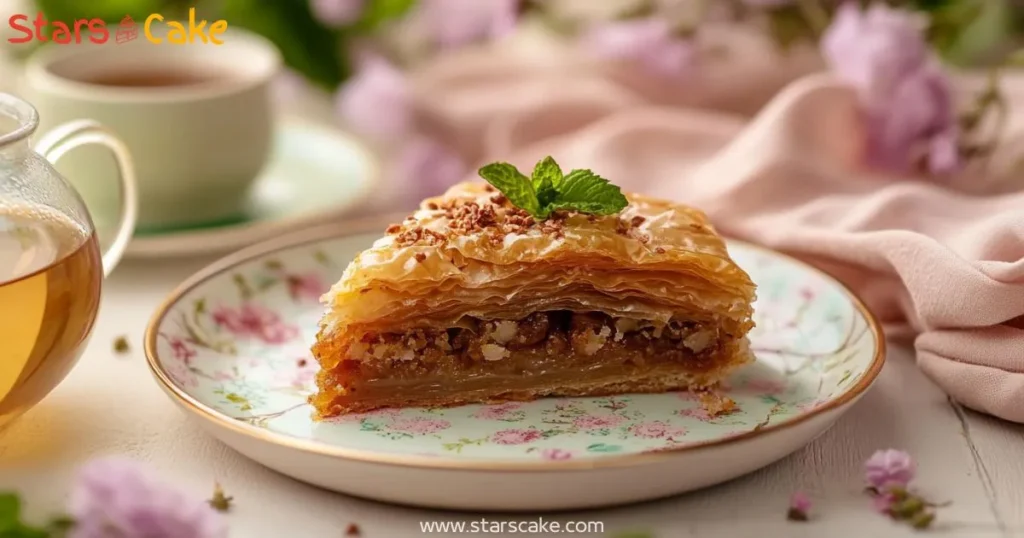
How to Serve Baklava Cake Beautifully
Once your baklava cake has absorbed all that sticky honey-orange syrup, it’s time to plate it up—and trust me, this cake deserves a little moment. You can serve it as a single tall layer, or go for a two-tier look if you’ve made multiple layers. A simple dusting of powdered sugar or a light drizzle of extra honey can take it from “yum” to “wow” in seconds.
Want to really impress guests? Garnish with a few candied orange peels or a sprinkle of crushed pistachios around the edge of the plate. It creates a beautiful contrast with the golden tones of the cake. This is the kind of dessert that feels right at home on a holiday table, next to something like Christmas spice snowball cookies.
Whether it’s a family gathering or just a sweet afternoon moment with tea, this cake pairs wonderfully with unsweetened beverages. Try a mint tea, Turkish coffee, or even a glass of cold milk to balance the richness.
Storage Tips & Make-Ahead Magic
One of my favorite things about this baklava cake is how well it keeps. The honey syrup actually helps preserve the cake, keeping it moist and flavorful for up to four days at room temperature. Simply cover it loosely with foil or store it in an airtight container once it’s fully cooled. You don’t want to refrigerate it unless your kitchen is especially warm, as cold temperatures can dry it out.
If you’re planning ahead for a party or event, you can bake the cake the night before and drizzle the syrup in the morning. Even better? It tastes richer the next day. That’s the kind of baking that fits beautifully into a busy life—just like my make-ahead lemon yogurt bars that our readers love for brunches and birthdays.
You can even freeze individual slices (without syrup) and reheat them before serving—just spoon a bit of warm syrup over the top after thawing. It’s a sweet trick for bakers who like to prep in advance.
Conclusion
If you’ve never tried baklava cake before, now’s the time. It’s cozy, aromatic, and packed with flavor, but without all the tricky layers of traditional baklava. From the cinnamon-kissed walnuts to the honey-orange syrup, each bite tells a story—and that story is meant to be shared.
Whether you’re baking for a holiday, a birthday, or a quiet Sunday afternoon, this cake is a celebration on its own. And remember, baking isn’t about perfection. It’s about joy, creativity, and making something beautiful for the people you love.
So gather your ingredients, pour yourself some tea, and enjoy every sticky-sweet slice of this special treat.
FAQ
Is a baklava a cake?
Traditionally, baklava is not a cake but a layered pastry made with phyllo dough, nuts, and sweet syrup. However, baklava cake reimagines those same flavors—nuts, spice, and honey—in a tender layer cake format that’s easier to bake and share.
What nationality is the dessert baklava?
Baklava has deep roots in Middle Eastern, Greek, and Turkish cuisines. Many cultures claim it as their own, and while its exact origin is debated, it remains a treasured dessert across the Mediterranean and the Middle East.
What is the difference between Greek and Turkish baklava?
Greek baklava often uses walnuts and honey and is spiced with cinnamon and clove. Turkish baklava typically features pistachios, no spices, and a syrup made with sugar and lemon. Both are delicious, but the flavor profiles are slightly different.
Is baklava a Greek or Turkish dessert?
Both! Baklava is deeply woven into the culinary history of both Greece and Turkey, and variations exist throughout the Levant and beyond. This baklava cake takes inspiration from both versions but presents it in a totally new, easy-to-bake format.
Is baklava healthy or unhealthy?
Baklava is rich in nuts, which offer good fats and protein, but it’s also high in sugar and calories. It’s definitely a “sometimes” treat—perfect for special occasions, like our honey walnut cake.
Is baklava expensive?
Traditional baklava can be pricey due to ingredients like nuts, butter, and phyllo dough. But this cake version uses pantry staples and is much more affordable to make at home.
Why is baklava so good?
It’s all about contrast—crunchy and soft, sweet and spiced, buttery and nutty. This cake keeps all of that flavor but makes it easier for families to enjoy together.
